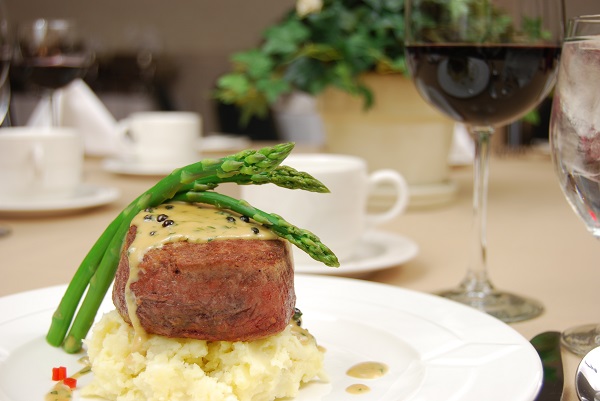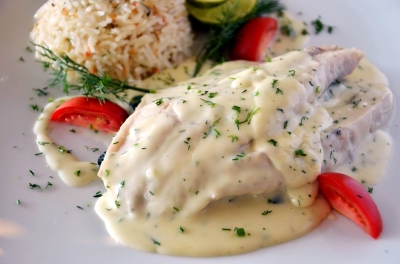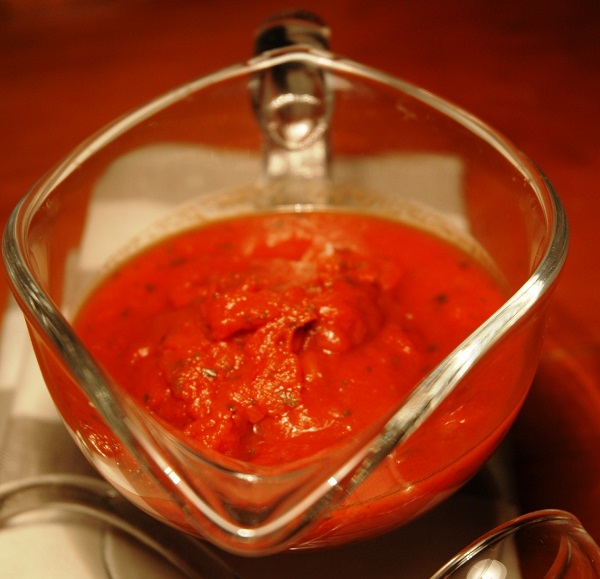A Mother Sauce is a basic recipe that can be used on its own or as a starting point for far-flung variations.
The fundamental components of any sauce are liquid, thickener, and flavoring agents. Each of the Mother Sauces is distinguished by the combination of the basic ingredients. In turn, when the basic ingredients are substituted or enhanced, the result is called a small sauce.

Come to Momma
The 5 Mother Sauces are:
- Sauce Béchamel: milk-based sauce, thickened with a white roux
- Sauce Espagnole: a fortified brown veal stock sauce
- Sauce Velouté: white stock-based sauce, thickened with a roux
- Sauce Hollandaise: an emulsion of egg yolk, butter, and lemon or vinegar
- Sauce Tomate: tomato-based
Roux
Roux is probably the most common type of thickening agent for sauces, and is made from equal amounts of fat and flour. First, the fat is heated and then the flour is whisked in until the mixture is smooth with a paste-like consistency.
Roux can be cooked to attain various hues from white to caramel to black. At each stage the flavor of the roux intensifies from a light, nutty flavor to an earthy, dark flavor that gives Cajun and Creole-style gumbos their distinctive flavors.
Béchamel
This is a classic white sauce made by combining equal parts of melted butter and flour to create a roux. The roux is cooked lightly before being combined with milk. Other flavorings, such as bay leaf, onion, or a pinch of nutmeg, can tailor the flavor according to its use.
Béchamel is the foundation for many macaroni and cheese recipes. Cheddar, Fontina, and other cheeses can be added slowly to a Béchamel to create this creamy classic. Among the most popular variations, Sauce Mornay is Béchamel with the additions of Gruyère and Parmesan, which is fundamental to the classic French dish of creamed scallops—coquilles St. Jacques.
Béchamel, however is not limited in use to French cuisine. You’ll find Béchamel used in the original Italian version of lasagna and in Greek pastitsio and moussaka.
Espagnole

This is the classic brown sauce, but it’s rarely used on its own. Espagnole starts with a roux that is cooked until it is a light brown hue. To this, veal stock is added and, toward the end of the cooking time, tomato paste joins the mix.
Espagnole is the foundation for making demi-glace, a sauce reduction that is highly concentrated and used to fortify small sauces.
Some of the most popular variations include Sauce Bordelaise in which red wine—usually Bordeaux—and shallots are added to the Espagnole. Sauce Madeira is very similar, except the wine added to the sauce is Madeira.
Velouté
Sauce Velouté is characterized by the type of stock incorporated into it. First a roux is cooked to a blond color. To this, chicken, fish, or veal stock is added and defines the overall flavor and application of the sauce.
Adding wine and heavy cream to a fish-stock-based sauce creates White Wine Sauce, a popular finishing touch for fish and seafood dishes. Sauce Supreme is Velouté with chicken stock and Sauce Allemande incorporates veal stock.
Hollandaise
Without the use of a roux, Hollandaise is an emulsion based on the thickening power of egg yolks mixed with butter and (usually) lemon juice. It is a rich sauce, yet light on the palate. Hollandaise may be the most temperamental of the Mother Sauces. It takes a steady hand and a mastery of heat control to ensure a smooth, creamy sauce. Too much heat and the mixture will break and separate, leaving you with scrambled egg yolks.
Eggs Benedict is a hallmark dish featuring Hollandaise Sauce. Asparagus—both green and white—are often accompanied by a final nap of Hollandaise.
Probably the most well-known small sauce from Hollandaise is Sauce Béarnaise, which—with the addition of tarragon—becomes an assertive topping for beef and other hearty meats.
Sauce Choron is a variation on a variation: Sauce Béarnaise to which tomato is added. Sauce Mousseline is Hollandaise with whipped cream folded in.
Tomate

In the French tradition, Sauce Tomate is a simple sauce—related to, but different from, the type of tomato sauce we associate with Italian cuisine. In Sauce Tomate, the tomatoes themselves are the thickening agent, although a roux is still an option.
Aside from tomatoes, only olive oil and salt are used in its preparation. The result is something akin to ketchup. From there, the additions of sweated onions and/or garlic, parsley, oregano, and other seasonings lead to everything from Italian Sunday gravy (red sauce) to pungent Creole sauce to Indian Makhani.
Some type of tomato sauce is known the world over from France, Italy, and Spain, to India, Mexico, and Australia—wherever tomatoes are cultivated.
Did you know all sauces could be traced back to these Five Mother Sauces? What’s your favorite sauce or variation? What’s the most amazing sauce you’ve ever had?



Leave Your Response